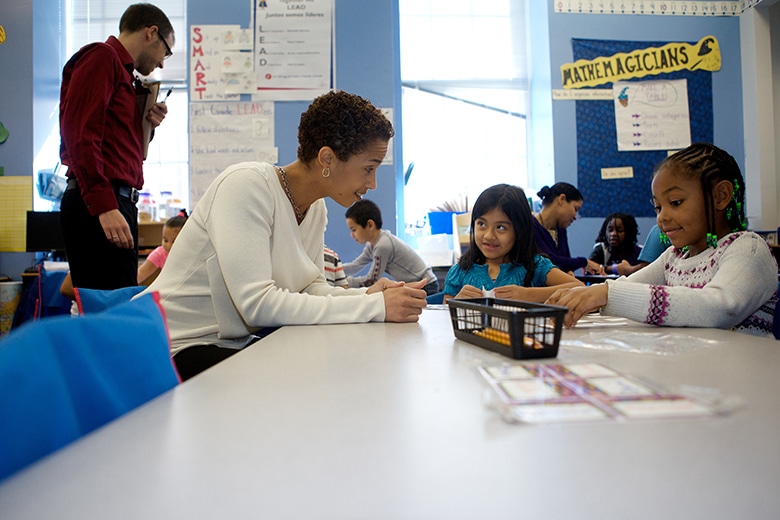The Learning Sciences Supports the Shift to Student-Centered Learning
Education Domain Blog
The findings from the learning sciences support the shift to student-centered learning models, such as competency-based education and personalized learning. Many of the necessary elements of designing environments based on how students learn best are embedded in student-centered learning models. For all students to succeed in K-12 education, they must be provided with multiple ways to demonstrate their knowledge, and educators must continuously monitor student pace and progress and provide interventions to keep students on track to meet their goals. This requires a shift in how we currently design teaching and learning in schools and enable supportive policies for student-centered learning.
New Definitions of Student Success and a Focus on Putting Students at the Center of Learning
In the current education policy environment, graduation requirements, learning outcomes, and learning measures have substantial influence in determining how schools are organized. Outcomes and measures shape how students experience learning through the selection of content, instructional strategies, and assessments. Traditional models tend to emphasize lower levels of Bloom’s Taxonomy. They expect students to prove basic recall and comprehension of content knowledge aligned to grade-level standards. Student-centered learning systems, such as competency-based education, emphasize a balance between broad content knowledge and enduring understandings of key concepts and skills.
As educators and leaders embrace this expanded definition of student success, they will find it necessary to make very different decisions about student experiences, instructional strategies, district policies, and the culture of learning. It is helpful to think about the role of outcomes with regard to systems design in two ways: First, outcomes can be used to engage in backward design. When we know what we want to be true for students in their adulthood, we can define graduation expectations, critical learning, and development milestones and find ways to define and assess readiness and progress.
Second, outcomes can be used to frame how we think about students’ experiences throughout the process of learning. We can use our understanding of student success to inform what students experience at different points in their learning and what supports they need at different stages of their development.
Opportunities for K-12 Education Systems to Shift Toward Student-Centered Learning
Mounting evidence demonstrates that integrating social, emotional, and academic development boosts outcomes in children and youth. State policymakers, therefore, have a unique opportunity to ensure learning systems are working off of research on how students learn best. New findings from the learning sciences can be translated into more effective practice. There are tremendous opportunities for research and development to push the field even further and to improve outcomes for young people and society at large.
There is also a need to call on educators and leaders in youth-serving organizations across the K-12 education ecosystem to embrace an integrated approach to educating the whole child. There are many opportunities for policymakers at the state, local, and in some cases, federal levels for leadership.
This effort should not be viewed as a new initiative. Rather, it is an opportunity to better align the K-12 education ecosystem so that each and every student can develop into a lifelong learner and engaged citizen through supportive, engaging, and challenging experiences both in and out of school. In pursuing this work, state and local leaders should acknowledge the expertise within state education agencies, district offices, and other key state, district, and community partners to help with implementation, staff capacity, reporting, and data collection. They should consider opportunities to help share knowledge and resources across these groups. It is important to elevate the voices of marginalized communities to ensure efforts and decisions are inclusive of vulnerable populations. State and local agencies along with their community partners may already have significant work underway that can and should be leveraged and amplified.
At the core of these recommendations is a new vision for how state players and their local partners can operate in a more collaborative, coherent fashion to support each community’s vision for teaching and learning, informed by best practice. This vision requires moving from:
- Practices driven by policy compliance to enabling policies that support best practice;
- Disconnected programs and supports to integrated and aligned strategies that focus on the well-being of the whole child;
- Deficit frames for accountability to using multiple measures and evidence for continuous improvement; and,
- A definition of success limited to percentages of students who are grade-level proficient, to a more inclusive definition that reflects the mastery of social, emotional, and academic competencies as well as civic awareness, informed by a broad, collaborative network of partners.
In this way, we can ensure each and every child receives a quality education and comprehensive supports needed to succeed in school, in the evolving workplace, and in community and civic life.
Learn More:
- Issue Brief – Future Focused State Policy Actions to Transform K-12 Education
- Issue Brief – Federal Policy Priorities to Accelerate Education Innovation
- Report – Fit for Purpose: Taking the Long View on Systems Change and Policy to Support Competency Education
- Issue Brief – Redefining Success: Profile of a Graduate
- Issue Brief – Innovation Zones: Created Policy Flexibility For Competency-Based Personalized Learning
- Blog Post – From Seat Time to Credit Flexibility in Personalized, Competency-Based Education
- Report – What is Competency-Based Education? An Updated Definition
- CompetencyWorks Blog Post – What the Learning Sciences Tell Us About Competency Education
Previous posts in this series:
